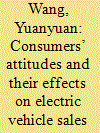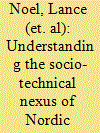|
|
|
Sort Order |
|
|
|
Items / Page
|
|
|
|
|
|
|
| Srl | Item |
| 1 |
ID:
185689


|
|
|
|
|
| Summary/Abstract |
There are close links and interactions among consumers' attitudes, the construction of charging infrastructure, and the diffusion of new energy vehicles (NEVs). This study focuses on consumers' sentient attitudes toward charging infrastructure and the effect of consumer attitudes toward the construction of charging piles and NEV sales using natural language processing technology and the panel vector autoregressive method. Consumers' sentient attitudes (i.e., positive, negative, and neutral) were inferred by analyzing consumer comments on charging infrastructure obtained from the internet. The key reasons for consumers' negative attitudes were further investigated, and the diversity in their attitudes was explored at the city level. The results show a growing concern for consumers about charging infrastructure since 2013. The overall satisfaction of consumers has constantly improved. The top pain points that cause consumers' negative attitudes are inconvenient charging, charging dilemmas, inability to install private charging piles, etc. Consumers' negative attitudes have a significantly positive impact on the charging piles’ construction. It also has a significantly negative impact on the sales of NEVs, but the effects are themselves short-term. Usually, the impact of negative attitudes is stronger than that of positive attitudes.
|
|
|
|
|
|
|
|
|
|
|
|
|
|
|
|
| 2 |
ID:
117255


|
|
|
|
|
| Publication |
2013.
|
| Summary/Abstract |
Federal electric vehicle (EV) policies in the United States currently include vehicle purchase subsidies linked to EV battery capacity and subsidies for installing charging stations. We assess the cost-effectiveness of increased battery capacity vs. nondomestic charging infrastructure installation for plug-in hybrid electric vehicles as alternate methods to reduce gasoline consumption for cars, trucks, and SUVs in the US. We find across a wide range of scenarios that the least-cost solution is for more drivers to switch to low-capacity plug-in hybrid electric vehicles (short electric range with gasoline backup for long trips) or gasoline-powered hybrid electric vehicles. If more gasoline savings are needed per vehicle, nondomestic charging infrastructure installation is substantially more expensive than increased battery capacity per gallon saved, and both approaches have higher costs than US oil premium estimates. Cost effectiveness of all subsidies are lower under a binding fuel economy standard. Comparison of results to the structure of current federal subsidies shows that policy is not aligned with fuel savings potential, and we discuss issues and alternatives
|
|
|
|
|
|
|
|
|
|
|
|
|
|
|
|
| 3 |
ID:
175232


|
|
|
|
|
| Summary/Abstract |
The construction of public-access electric vehicle charging piles is an important way for governments to promote electric vehicle adoption. The endogenous relationships among EVs, EV charging piles, and public attention are investigated via a panel vector autoregression model in this study to discover the current development rules and policy implications from the historical panel data in China. Five policies related to EV charging piles, EV purchase subsidies, commercial land prices, and retail gasoline prices are controlled as exogenous variables in the model. The results indicate that EV and charging piles diffusion do interact, and public attention plays a nexus role in EV and charging piles deployment. Reducing the electricity rate is the most effective policy approach to promote EV charging piles. Subsidising the construction cost has an insignificant impact on charging piles diffusion in this study, and several possible reasons have been discussed. The promotion effect of direct-current charging piles on EV sales is twice that of alternating-current charging piles in the one-year simulation of our model. Increasing the number of EV charging piles has a significant impact on battery electric vehicle sales but not on plug-in hybrid electric vehicle sales.
|
|
|
|
|
|
|
|
|
|
|
|
|
|
|
|
| 4 |
ID:
162274


|
|
|
|
|
| Summary/Abstract |
This study is the first to systematically and quantitatively explore the factors that determine, the length of charging sessions at public charging stations for electric vehicles in urban areas, with, particular emphasis placed on the combined parking- and charging-related determinants of connection, times. We use a unique and large data set – containing information concerning 2.6 million charging, sessions of 64,000 (i.e., 60% of) Dutch EV-users – in which both private users and taxi and car sharing, vehicles are included; thus representing a large variation in charging duration behaviour. Using, multinomial logistic regression techniques, we identify key factors explaining heterogeneity in charging, duration behaviour across charging stations. We show how these explanatory variables can be used to, predict EV-charging behaviour in urban areas and we derive preliminary implications for policy-makers, and planners who aim to optimize types and size of charging infrastructure.
|
|
|
|
|
|
|
|
|
|
|
|
|
|
|
|
| 5 |
ID:
185685


|
|
|
|
|
| Summary/Abstract |
Supporting the adoption of zero-emission vehicle (ZEVs), including plug-in electric vehicles (EVs), has become a priority for governments due to their ability to reduce petroleum demand, improve air quality, and reduce carbon dioxide (CO2) emissions. Optimal strategies to accelerate EV adoption must weigh the relative value of alternative policy mechanisms to consumers, including public charging infrastructure and vehicle purchase subsidies. We use a historically validated light-duty vehicle consumer choice tool, the ADOPT model, to simulate personal light-duty vehicle adoption and related emissions in California. ADOPT is updated to incorporate a quantification of the tangible value of public charging infrastructure, allowing us to simulate the impact of investments in public charging infrastructure and vehicle purchase subsidies under different scenarios. We show that both policies result in increased EV adoption, with the most effective policy varying depending on vehicle technology assumptions. Under conservative technology improvement assumptions, infrastructure investments are most effective in promoting EV sales and reducing CO2 emissions, while under optimistic technology improvement assumptions a combination of infrastructure and subsidies best supports EV sales and CO2 emission reductions.
|
|
|
|
|
|
|
|
|
|
|
|
|
|
|
|
| 6 |
ID:
150790


|
|
|
|
|
| Summary/Abstract |
The analysis of economic implications of innovative business models in networked environments, as electro-mobility is, requires a global approach to ensure that all the involved actors obtain a benefit. Although electric vehicles (EVs) provide benefits for the society as a whole, there are a number of hurdles for their widespread adoption, mainly the high investment cost for the EV and for the infrastructure. Therefore, a sound business model must be built up for charging service operators, which allows them to recover their costs while, at the same time, offer EV users a charging price which makes electro-mobility comparable to internal combustion engine vehicles. For that purpose, three scenarios are defined, which present different EV charging alternatives, in terms of charging power and charging station ownership and accessibility. A case study is presented for each scenario and the required charging station usage to have a profitable business model is calculated. We demonstrate that private home charging is likely to be the preferred option for EV users who can charge at home, as it offers a lower total cost of ownership under certain conditions, even today. On the contrary, finding a profitable business case for fast charging requires more intensive infrastructure usage.
|
|
|
|
|
|
|
|
|
|
|
|
|
|
|
|
| 7 |
ID:
171472


|
|
|
|
|
| Summary/Abstract |
Electric vehicles are perceived as a key alternate to internal combustion engine vehicles for a transition to a decarbonized society. However, this transition towards the electrification of transport has not made equal progress globally, and faced several impediments to consumer adoption of EVs across the Nordic region and beyond. While there has been a multitude of reasons provided in the literature, we aim to characterize the barriers that remain to electrification today, as well as their perceived interconnections and futures. To provide insight into this query, the authors conducted 227 semi-structured interviews with transportation and electricity experts from 201 institutions across seventeen cities in Denmark, Finland, Iceland, Norway, and Sweden. The qualitative results and consequent cluster analysis show that common barriers like range, price and charging infrastructure continue to persist, despite technological advancements over the recent years. At the same time, results also show that barriers are highly interconnected and are commonly connected to consumer knowledge and experience. The article concludes with a discussion of policy implications of the findings and potential future research.
|
|
|
|
|
|
|
|
|
|
|
|
|
|
|
|
|
|
|
|
|